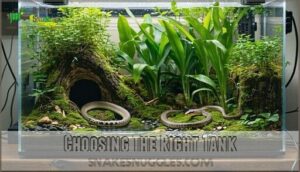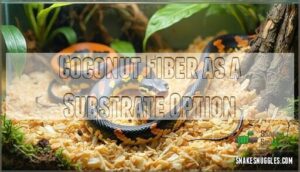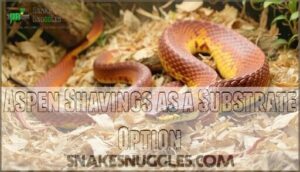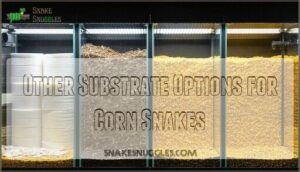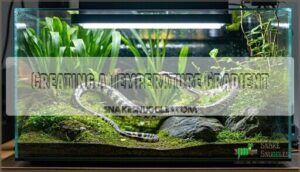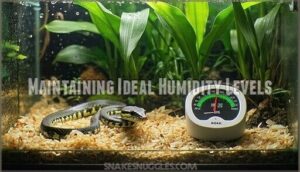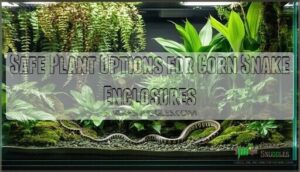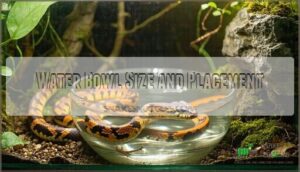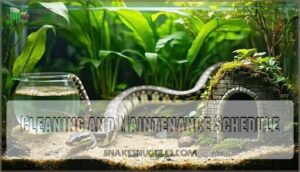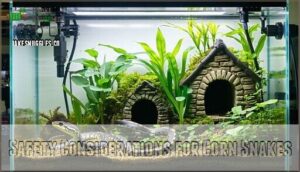This site is supported by our readers. We may earn a commission, at no cost to you, if you purchase through links.
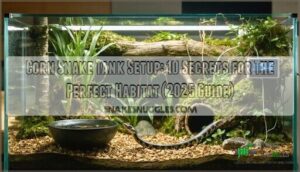 Setting up a corn snake tank requires the right balance between comfort and practicality.
Setting up a corn snake tank requires the right balance between comfort and practicality.
Start with a secure enclosure, at least 20 gallons for juveniles and 40 gallons for adults.
Glass tanks work great, but verify proper ventilation.
Use aspen shavings or coconut fiber for substrate—it’s cozy and easy to clean.
Maintain a temperature gradient: 75-82°F on the cool side and 85-90°F in the basking spot.
Add hiding spots, a shallow water bowl, and climbing structures for enrichment.
Keep the humidity around 40-60%, using a hygrometer to monitor.
With the right setup, your snake will feel right at home—safe, happy, and thriving!
Table Of Contents
- Key Takeaways
- Choosing The Right Tank
- Selecting The Best Substrate
- Creating a Temperature Gradient
- Lighting Requirements for Corn Snakes
- Maintaining Ideal Humidity Levels
- Essential Hiding Spots and Enrichment Items
- Decorating The Enclosure
- Water Bowl Size and Placement
- Cleaning and Maintenance Schedule
- Safety Considerations for Corn Snakes
- Frequently Asked Questions (FAQs)
- What do corn snakes need in their tank?
- What is the best setup for a corn snake?
- Do corn snakes like heat mats or lamps?
- How to set up a cage for a corn snake?
- What is the best tank for a corn snake?
- Where should a corn snake tank be located?
- How to set up a corn snake terrarium?
- How do you introduce a new corn snake tank?
- What does a corn snake tank need?
- Is a 40 gallon tank big enough for a corn snake?
- Conclusion
Key Takeaways
- Pick a secure enclosure (at least 40 gallons for adults) with proper ventilation and a tight-fitting lid.
- Maintain a temperature gradient with a warm basking spot (85-90°F) and a cooler side (75-82°F) while keeping humidity at 40-50%.
- Add hiding spots, climbing structures, and a moisture-retaining substrate like aspen shavings or coconut fiber for comfort and enrichment.
- Regularly clean the enclosure, spot-clean daily, and deep clean every 4-6 weeks to keep your corn snake healthy and stress-free.
Choosing The Right Tank
You’ll need to select a tank that’s at least as long as your corn snake with a minimum of 40 gallons for adults, ensuring they’ve enough space to stretch out completely.
Glass enclosures are recommended for better viewing and cleaning, but make sure your tank has proper ventilation and a secure lid to prevent your curious serpent from planning a great escape, utilizing proper ventilation.
Tank Size Requirements for Corn Snakes
The perfect tank size for your corn snake evolves with their growth.
Hatchlings thrive in 10-20 gallon enclosures, while juveniles need 20-30 gallons to explore.
Adult dimensions should accommodate a minimum 40-gallon tank, allowing your snake to fully stretch out.
The perimeter rule suggests your enclosure’s edge should measure twice your snake’s length.
While corn snakes don’t require excessive vertical space, they do appreciate climbing opportunities.
For a 4-5 foot adult, aim for a tank at least 48"L × 24"W × 24"H.
Remember, adequate space prevents stress and promotes natural behaviors.
Many vendors offer various enclosure sizes to meet these needs.
Glass Vs. Plastic Enclosures for Corn Snakes
Deciding between a glass tank and a plastic tub for your corn snake tank setup? Let’s break it down.
Glass tanks shine in terms of clarity, scratch resistance, and visibility. They’re heavier but worth the weight if you value watching your snake’s natural behavior. For long-term use, tempered glass enclosures are sturdy and escape-proof.
On the flip side, plastic tubs are lightweight, cost-efficient, and retain heat well. However, their visibility can be limited, making it harder to monitor your pet.
Here’s a quick comparison:
- Clarity comparison: Glass wins for viewing ease.
- Weight differences: Plastic is lightweight, glass is hefty.
- Heat retention: Plastic holds heat better.
- Cost analysis: Plastic tubs are budget-friendly.
Ventilation Considerations for Corn Snakes
Your corn snake’s health depends on proper airflow. Poor snake enclosure ventilation can trap stale air, harming your pet.
Use tanks with mesh tops or secure air holes to balance humidity control and meet respiratory health needs. Too much ventilation can dry the habitat, while too little may encourage mold. Aim for moderate airflow.
Proper vent placement encourages natural airflow.
| Factor | Impact on Snake | Solution |
|---|---|---|
| Low Airflow | Mold, poor health | Add mesh top or vents |
| Excessive Airflow | Dry habitat | Reduce vent size |
| Balanced Ventilation | Healthy environment | Adjust daily humidity |
Tweak the setup to prevent issues and keep your corn snake thriving.
Selecting The Best Substrate
Choosing the right substrate keeps your corn snake healthy and comfortable. It’s important to pick a material that’s safe, easy to clean, and helps maintain proper humidity.
Coconut Fiber as a Substrate Option
When selecting the best snake substrate options, coconut fiber stands out for corn snake bedding.
Its fiber humidity retention helps keep the ideal 40-50% range, reducing stress. With excellent cost-effectiveness, it’s safe even if swallowed by accident.
Here’s why it’s one of the best substrate corn snake choices:
- Absorbs moisture, preventing mold growth.
- Offers perfect burrowing texture with fine fiber particle size.
- Keeps airy but not overly dusty (coconut fiber dust control).
- Available online or pet stores.
Aspen Shavings as a Substrate Option
Aspen shavings are a favorite among snake substrate options, offering burrowing fun and easy spot-cleaning. Yet, their dust content can irritate, so shake them well before use. Watch for mold risk in damp enclosures.
Owners can easily shop for bedding online.
| Aspen Pros | Aspen Cons |
|---|---|
| Lightweight, burrowable | Dust Content |
| Absorbent, affordable | Mold Risk |
| Easy to maintain | Replace often |
For cost-conscious owners seeking the best substrate, corn snake bedding like aspen shavings fits most enclosure setups.
Other Substrate Options for Corn Snakes
If aspen shavings or coconut fibers aren’t your top pick, several other snake-friendly substrates can work wonders.
Consider these options:
- Paper towels: Perfect for easy cleaning and health monitoring.
- Reptile carpet: A reusable, budget-friendly choice requiring regular cleaning.
- Cypress mulch: Ideal for humidity control and maintaining a natural look.
- Soil mixtures with sand alternatives: Mimic natural habitats while supporting burrowing.
Always maintain a 3–4 inch depth for your corn snake’s comfort, and remember regular substrate replacement for a clean, safe enclosure.
Proper maintenance helps prevent salmonella and mites in the habitat.
Creating a Temperature Gradient
Creating a proper temperature gradient is essential for your corn snake’s health and comfort. It lets them move between warm and cool zones to regulate their body temperature effectively.
A balanced temperature gradient keeps your corn snake happy, healthy, and thriving by mimicking nature’s warmth and cool retreat zones.
Basking Area Setup for Corn Snakes
How do you create the perfect basking area? Start by placing a heat lamp on one side of the tank to maintain balance in your setup.
Your basking area should reach 88-95°F to keep your snake happy.
Use flat rocks or sturdy branches (safe material matters!) and position them cautiously to prevent burns—Basking Distance Safety is key.
Use reliable Temperature Monitoring Tools, like a thermometer, for precise temperature control in your heating corn snake tank.
Cold Side Temperature Management for Corn Snakes
After setting up the basking area, it’s time to focus on the cool side. Maintaining a temperature range of 75-82°F is key for your snake’s comfort and health. This gradient impact lets them move freely between warmer and cooler spots, imitating nature’s design.
Make the cold area inviting with:
- Thermometer placement to monitor and guarantee precise temperature control.
- A snug, shaded hide where your snake feels secure.
- A small water dish to handle hydration and support seasonal adjustments.
- Plants or branches for a cozy, natural vibe.
Nighttime temperature drops below 65°F should be avoided, so stick to this range to keep your corn snake happy!
Heating Equipment Selection for Corn Snakes
Keeping the right temperatures is where heating gear shines.
Heat lamps deliver warmth to basking spots, with wattages between 50-100W.
Ceramic heaters, at 60-150W, offer steady nighttime heat without light.
For under-tank warmth, heat mats (8-24W) work wonders but need thermostats for safety.
A thermometer guarantees proper temperature control while preventing overheating.
Place heat sources strategically—top for lamps and heaters, bottom for mats—to build a basking zone.
Safety tip: always follow manufacturer guidance to prevent accidents.
Corn snake supplies are readily available online.
Lighting Requirements for Corn Snakes
Proper lighting helps maintain your corn snake’s health and mimics natural day and night cycles. While they don’t need intense lighting, providing UVB can support overall well-being and activity.
Day/Night Cycle Simulation for Corn Snakes
A consistent photoperiod length is essential for your corn snake’s circadian rhythm.
Aim for 10-12 hours of lighting daily, simulating natural daylight. Use timers to simplify things, and adjust lighting gradually during seasonal variations.
Artificial light works well, but avoid disrupting their behavioral changes. Make certain the light spectrum supports a natural feel.
At night, maintain the proper nighttime temperature, as sudden shifts can stress your snake. It’s all about creating balance and comfort!
UVB Lighting Considerations for Corn Snakes
Corn snake lighting isn’t just about visibility—it’s about health. UVB lighting helps improve their vitamin D levels, which supports bone strength and overall well-being.
Stick with reliable brands like Zoo Med and Arcadia for a safe, consistent light source.
- Bulb Placement: Position UVB 9-14 inches above their basking area, avoiding glass barriers.
- Spectrum Requirements: Use low-output bulbs like T5 HO UVB tubes for gentle illumination.
- Light Duration: Mimic seasons with 13-hour summer days and 11-hour winter days to align their circadian rhythm.
Maintaining Ideal Humidity Levels
Keeping your corn snake’s habitat at the right humidity level is essential for its health and shedding.
Use simple tools like a hygrometer, regular misting, and proper water bowl placement to maintain a consistent range of 40-50%.
Humidity Range for Corn Snakes
Maintaining the right humidity for your corn snake’s habitat is like striking the perfect balance on a seesaw—it’s critical for their health and comfort. Aim for a steady 40-50% humidity, which supports smooth shedding and helps prevent respiratory infections.
Striking the perfect humidity balance ensures smooth shedding and keeps your corn snake healthy, stress-free, and thriving in its ideal habitat.
By keeping the balance, you’ll create a space where your snake thrives, avoiding potential health issues caused by improper moisture levels.
To make managing humidity simple:
- Use a hygrometer to monitor humidity accurately and calibrate it periodically for best results.
- Choose moisture-retaining substrates like coconut fiber or aspen, which help stabilize humidity levels.
- Adjust ventilation carefully—a well-ventilated tank prevents excess moisture while retaining what’s needed.
- Watch seasonal changes, as indoor conditions can shift with the weather.
Perfecting snake tank humidity control keeps your pet safe and stress-free.
Misting and Water Bowl Placement for Corn Snakes
Humidity is essential for a healthy corn snake, and misting frequency plays a big role.
Lightly mist the enclosure every other day, focusing on the cool side.
Use a wide, shallow water bowl made of sturdy, non-toxic material, like ceramic or plastic, and place it on the cool side, far from the heat source.
The bowl size should allow your snake to soak comfortably, ensuring a natural humidity gradient that balances moisture levels while preventing excessive dampness and mold buildup in your corn snake’s habitat, which is crucial for maintaining a healthy environment with the right level of humidity.
Hygrometer Usage for Corn Snakes
A hygrometer is essential for humidity management in your corn snake’s habitat, ensuring reading accuracy and balanced environmental conditions.
Place it in the tank’s middle for ideal results. Aim for 40-50% humidity, perfect for your snake’s health.
Digital options often outperform analog for ease of use and precise readings. Regularly check and calibrate the device if needed.
Address humidity problems promptly—maintaining proper conditions prevents stress and supports shedding in your scaly friend, which is crucial for its overall health!
Essential Hiding Spots and Enrichment Items
Your corn snake’s enclosure isn’t complete without proper hiding spots and enrichment items to keep them active and stress-free.
Providing a mix of natural hides, climbing structures, and burrowing areas guarantees a secure and stimulating habitat for your snake.
Natural Vs. Artificial Hides for Corn Snakes
Creating safe and secure hiding places is a key part of your snake enclosure setup. Whether you choose natural aesthetics or artificial designs, your corn snake will appreciate a variety of snake hides.
Natural hides, like cork bark or wood logs, add a wild touch to the tank and support your snake’s instincts. Artificial options, such as plastic caves, provide easy cleaning and cost comparison benefits.
Place hides on both warm and cool sides to let your snake regulate its body temperature.
- Natural options: Cork bark, tree branches, rock formations
- Artificial solutions: Ceramic shelters, plastic snake hide boxes, reptile-safe items
- Cleaning ease: Plastic hides clean faster than porous materials
- Snake security: Make certain all hides are stable and collapse-proof
Climbing Structures and Branches for Corn Snakes
Your corn snake loves to climb, so give it a fun and enriching playground! Add climbing branches snake setups using natural materials like oak, grapevine, or sanded driftwood for snake enrichment.
Securely place the climbing branches at varied heights to encourage natural movement and exploration. For extra ease, PVC pipes make durable, safe structures.
Double-check branch safety—everything should be stable and escape-proof. Proper structure placement makes climbing both beneficial and safe for your corn snake.
Substrate Burrowing Areas for Corn Snakes
Great hiding spots aren’t just about climbing – they’re also about letting your snake go underground.
Burrowing areas tap into a corn snake’s natural behaviors, making your enclosure feel like home.
Here’s how these zones make a difference:
- Stress relief: Snakes feel safer when they can dig and hide.
- Temperature control: Burrowing provides access to cooler spots.
- Tunnel stability: A dense, packed substrate supports their favorite digs.
- Moisture gradient: Deeper layers help manage humidity.
Use 3-4 inches of the right substrate – loose but firm – to encourage safe burrowing.
Selecting non-toxic substrate materials is essential for their health and safety.
Watch your corn snake habitat come alive beneath the surface!
Decorating The Enclosure
When decorating your corn snake’s enclosure, focus on creating a setup that’s both functional and natural-looking.
Choose safe plants, rocks, and wood to provide hiding spots, climbing areas, and a habitat that mimics their environment.
Safe Plant Options for Corn Snake Enclosures
Adding greenery to your snake enclosure enhances its look and creates a cozier, more natural corn snake habitat. Whether you go for live or artificial plants, safety comes first—some plants are toxic or have sharp edges, which can harm your pet.
For live plants, stick with pothos, snake plants, and ferns. They’re non-toxic, have manageable root systems, and increase humidity. Verify proper cleaning of plants regularly to avoid mold. Keep an eye on plant placement to prevent tipping or crowding.
Artificial plants are a fantastic option too. While they won’t affect humidity, they’re easy to clean and long-lasting. Place them strategically to create hiding spots.
Ultimately, integrating safe greenery—live or artificial—creates a stress-free, bioactive corn snake setup your pet will enjoy.
Rock and Wood Selection for Corn Snake Enclosures
When selecting rocks and wood for your snake’s enclosure, focus on rock porosity and wood toxicity.
Smooth, porous rocks make great basking spots, while branches or logs create climbing and hiding opportunities.
Pay attention to size considerations—items should be suitable for your snake to navigate safely. Make certain secure placement to prevent shifting.
For a natural aesthetic, sanitized or store-bought pieces are ideal. Proper decor enhances safety and comfort, giving your snake a cozy, functional habitat.
Water Bowl Size and Placement
A properly sized water bowl is essential for your corn snake’s hydration and occasional soaking needs.
Place it in a secure, easy-to-access spot, ensuring it’s not too close to the heat source to prevent evaporation or overheating, which is crucial for maintaining the right environment for your pet.
Providing a Water Bowl for Drinking and Soaking
Your snake’s water bowl is more than just a dish—it’s their rejuvenating retreat. Opt for a heavy ceramic water bowl to prevent tipping and guarantee durability. Keep it on the cool side of the snake enclosure for balance.
Here’s why it matters:
- Bowl size importance: Large enough for soaking, small enough to avoid raising humidity.
- Soaking benefits: Helps with shedding and hydration.
- Water source safety: Prevents contamination.
- Humidity control: Essential for a happy, healthy corn snake.
Regular Cleaning and Refilling of The Water Bowl
Keeping your corn snake’s water dish clean is essential to prevent bacteria buildup.
Wash the bowl daily with hot water and mild soap to scrub away grime, then rinse thoroughly.
Choose durable bowl material to withstand cleaning frequency.
Refill the dish with fresh, dechlorinated water every day, following a consistent refilling schedule.
Place it on the cooler side of the snake tank to minimize contamination from substrate or heat, and ensure a clean environment for your pet by maintaining a routine that includes daily cleaning and refilling of the water dish with dechlorinated water.
Cleaning and Maintenance Schedule
Keeping your corn snake’s habitat clean is essential for its health and well-being. A consistent cleaning schedule prevents bacteria buildup, keeping your pet safe and stress-free.
Spot Cleaning Techniques for Corn Snake Enclosures
Spot cleaning keeps your corn snake’s enclosure fresh and healthy.
Think of it as a quick reset to limit problems like mold or odors.
Here’s your simple routine:
- Remove fecal matter and urates to prevent bacteria buildup.
- Clean up food spillage and replace soiled substrate.
- Check for mold prevention, wiping surfaces with reptile-safe cleaner.
- Keep substrate disturbance low, only replacing small areas.
Maintaining cleanliness also helps prevent respiratory health issues.
Your snake will appreciate this tidy, stress-free space!
Deep Cleaning Frequency for Corn Snake Enclosures
Regular snake cleaning keeps things tidy, but a deep clean guarantees a healthier space.
Every 4-6 weeks, completely refresh the enclosure. Remove substrate, scrub decorations, and wipe surfaces thoroughly.
This snake cleaning routine prevents waste buildup, supports parasite prevention, and helps with odor control. Use fresh substrate replacement and safe disinfectant selection.
Snake deep cleaning isn’t just maintenance—it’s critical for your snake’s well-being and a fresher, cleaner environment for everyone involved.
Disinfection Methods for Corn Snake Enclosures
Deep cleaning your snake’s tank starts with using safe disinfectants to avoid harsh chemical exposure.
A 10% bleach solution is effective—just make certain of proper contact time (10-15 minutes).
Rinse thoroughly to remove residues, keeping things snake-friendly.
Try a water and vinegar solution for a gentler approach to snake enclosure sterilization.
For frequent maintenance, spot-clean daily and use reptile-friendly cleaning chemicals.
Soak removable decor in disinfectants or sterilize with heat methods like baking.
Stick to a practical disinfection frequency—monthly deep cleans keep your pet’s habitat safe and healthy.
Safety Considerations for Corn Snakes
Keeping your corn snake safe starts with a secure, well-designed enclosure that prevents escapes and avoids harmful materials.
Pay attention to lid security, proper ventilation, and avoiding sharp or toxic items to create a safe and stress-free environment.
Escape-Proofing Measures for Corn Snake Enclosures
Your corn snake’s knack for sneaky escapes can keep you on your toes.
Guarantee tight lid security with lockable tops and weighted lids. Sealing gaps in tank materials and walls is key to escapeproof safety.
Keep cords hidden, as snakes may use them to climb. Smaller ventilation holes prevent squeezing through. Shallow substrate along walls keeps your snake grounded.
Prioritize strong locks—snake tank security is worth the peace of mind!
Avoiding Harmful Materials for Corn Snake Enclosures
When setting up your snake’s enclosure, some materials are a no-go.
Avoid toxic woods like cedar, as they release harmful oils.
Skip unsafe plastics that leach chemicals and any harmful paints prone to chipping.
Watch out for lead exposure in old decor or fixtures.
Use reptile-friendly cleaning chemicals, as harsh ones can harm your snake.
Regular snake substrate replacement prevents impaction from debris.
Keep aromatic items, like certain oils, out of the tank; they’re a hazard to sensitive reptiles.
Proper Lid Security for Corn Snake Enclosures
Keeping your snake safe starts with a secure lid. Use lockable screen lids or sliding tops with strong locking mechanisms for foolproof snake enclosure escape prevention.
Avoid unsafe lid materials that could harm your pet. If you’re into DIY solutions, focus on childproofing options and maintaining proper snake tank ventilation.
Inspect regularly for weak points—after all, snake enclosure safety isn’t negotiable. A loose snake might spark adventure, but prevention is always the smarter choice.
Frequently Asked Questions (FAQs)
What do corn snakes need in their tank?
A proper tank for corn snakes needs secure ventilation, climbing branches, hiding spots, a water bowl, and a heat source.
Maintain temperature gradients, safe humidity, and ample space to stretch, bask, and explore, ensuring a proper environment for the snakes.
What is the best setup for a corn snake?
A 40-gallon tank works great for adults.
Aim for secure lids, 40-50% humidity, and a warm basking spot around 88°F.
Add climbing branches, hiding spots, and substrate for burrowing—it’s their comfort zone!
Do corn snakes like heat mats or lamps?
Corn snakes tolerate heat mats and lamps, but both must be used carefully.
Heat lamps work well for creating a natural temperature gradient, while heat mats can help maintain a cozy, consistent warmth beneath their habitat, providing a natural temperature gradient is not the focus, but rather the heat sources.
How to set up a cage for a corn snake?
Funny enough, setting up a corn snake’s home isn’t rocket science.
Use a secure tank matching its size, maintain temperature gradients (warm/cool sides), 40-50% humidity, cozy hides, climbing décor, and safe substrate.
What is the best tank for a corn snake?
A spacious, escape-proof tank with at least 40 gallons works best for adult corn snakes.
Look for a glass enclosure with good ventilation, a secure lid, and enough room for climbing, hiding, and stretching.
Where should a corn snake tank be located?
Think of it like choosing a comfy home—place the tank in a quiet, low-traffic spot away from direct sunlight, vents, or loud noises.
This helps your snake feel secure and stress-free.
How to set up a corn snake terrarium?
Start by choosing a secure, escape-proof tank at least 40 gallons.
Add a heat lamp for a warm spot, climbing branches, hiding areas, and substrate for burrowing.
Maintain proper temperatures, lighting, and humidity levels.
How do you introduce a new corn snake tank?
Nearly 85% of tank setups fail during introductions due to stress.
Gradually acclimate your corn snake by providing hiding spots, maintaining ideal temperatures (75-82°F), and allowing it a week to adjust before handling.
What does a corn snake tank need?
Your corn snake’s tank needs proper heating, humidity control, and a secure lid.
Add hiding spots, climbing structures, and a moisture-retaining substrate.
Maintain a temperature gradient and provide a water dish for hydration.
Is a 40 gallon tank big enough for a corn snake?
Picture your snake gliding smoothly across its habitat—a 40-gallon tank generally gives enough room for most adult corn snakes.
But larger or more active ones might need extra space to stretch and explore comfortably.
Conclusion
Creating the perfect corn snake tank setup involves balancing space, comfort, and functionality.
From choosing the right enclosure size to maintaining temperature and humidity, every detail matters.
Secure hiding spots, climbing structures, and a well-placed water bowl help mimic their natural environment.
Regular cleaning guarantees a healthy habitat for your snake.
With thoughtful planning and consistent care, you’ll set up a home where your corn snake thrives—happy, safe, and active, just the way they should be.
- https://www.quora.com/What-is-the-best-setup-for-a-corn-snake-over-the-different-stages-of-life
- https://community.morphmarket.com/t/preparing-for-our-first-corn-snake-resource-help-please/41009
- https://exoticdirect.co.uk/news/corn-snake-set-up-advice/
- https://www.rspca.org.uk/documents/1494939/0/Corn+Snake+Care+Sheet+%28PDF+363KB%29.pdf/eab3d86d-0531-0625-5056-ca75887626a8?t=1556101010993
- https://reptilesupply.com/blogs/how-to-guides/how-to-set-up-a-corn-snake-enclosure

